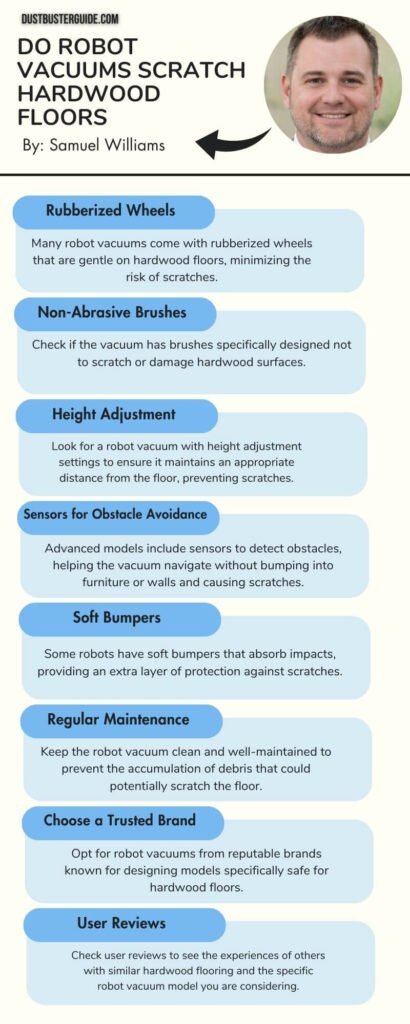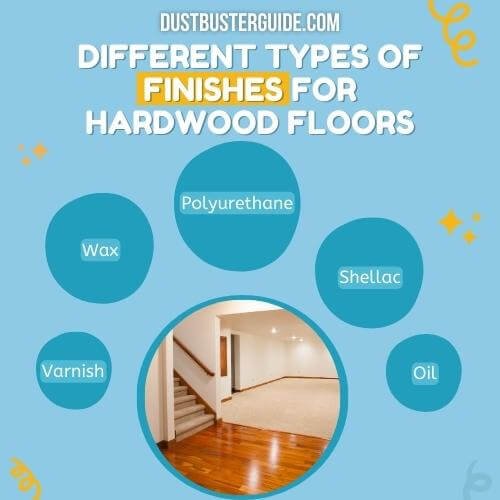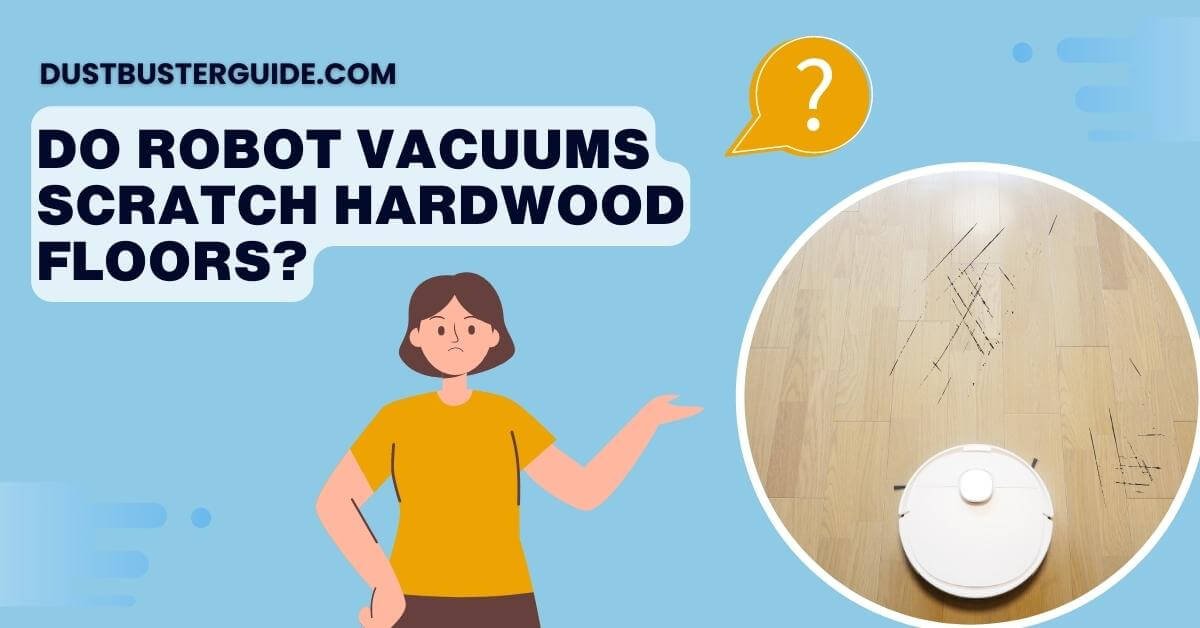In the delicate dance of robot vacuums and hardwood floors, concerns about potential scratches surface, lead to the question: do robot vacuums scratch hardwood floors? It’s an inquiry into the floor-friendly capabilities of these tech-savvy cleaning companions. Picture this: your diligent robot vacuum waltzing across hardwood floors, and the question arises. In just a couple of lines, the answer tiptoes into view: most robot vacuums are designed with anti-scratch features, but regular maintenance is essential.
But before you assume it’s a delicate performance, join us on this exploration. We’ll twirl through tips for hardwood floor care, ensuring your robot vacuum dances gracefully without leaving a mark.
Reasons Why Do Robot Vacuums Scratch Hardwood Floors
When it comes to the reasons why robot vacuums may scratch hardwood floors, there are several key points to consider. Let’s see what those are.
Hard Debris And Foreign Objects
Hard debris such as small rocks, pebbles, or metal objects can get caught in the brushes or wheels of the robot vacuum, causing it to leave scratches on your floors as it moves around.
Additionally, foreign objects like toys, shoes, or other household items left on the floor can also pose a risk. These objects can get stuck in the vacuum or cause them to bump into things, potentially damaging your hardwood floors.
Worn Out Or Damaged Brushes
The worn-out or damaged brushes on your vacuum can leave behind unsightly marks. Over time, the bristles on the brushes can become frayed or bent, which can cause them to scrape against your hardwood floors. This can result in scratches and scuff marks that detract from the beauty of your floors.
Additionally, if the brushes are damaged, they may not be able to effectively pick up dirt and debris, leaving behind a layer of grime on your floors. This can make your hardwood floors look dull and dirty, and may even lead to long-term damage if not addressed.
Lack Of Soft Bumpers
Lack of soft bumpers can leave behind unwanted marks and damage on your beautiful hardwood floors. When a robot vacuum lacks soft bumpers, it means that the edges and corners of the vacuum are not adequately protected. As the vacuum moves around your home, it may accidentally bump into furniture, walls, or other objects.
Without soft bumpers, these collisions can result in scratches or dents on your hardwood floors. The hard edges of the vacuum can leave behind visible marks that can be difficult to remove, especially on lighter-colored or glossy hardwood surfaces.

High Suction Power
With powerful suction, you’ll be amazed at how effortlessly it cleans your home. However, this high suction power can sometimes pose a problem for hardwood floors.
The strong suction force of robot vacuums can cause them to potentially scratch or damage the surface of the hardwood. As the vacuum moves across the floor, it may pick up small particles or debris, and if there are any loose or sharp objects present, they can get sucked up and dragged along the floor, leaving scratches in their wake.
Insufficient Sensors And Navigation
Without sufficient sensors and navigation systems, these vacuums may struggle to accurately detect obstacles and navigate around them, potentially causing scratches on your beautiful hardwood floors.
One of the main issues with insufficient sensors is that the robot vacuum may not be able to detect furniture legs, walls, or other objects in its path. This can lead to collisions and bumps, which can result in scratches on your hardwood floors.
Additionally, without advanced navigation capabilities, the robot vacuum may struggle to map out your home and efficiently clean every corner. This can lead to the vacuum repeatedly going over the same areas, increasing the risk of scratching the hardwood floors.
Harsh Cleaning Modes
You’ll be surprised at how easily your beautiful hardwood floors can be damaged when using the aggressive cleaning modes on some robot vacuum models. These harsh cleaning modes are designed to provide a deeper clean by increasing the suction power and brush rotation speed. While this may be effective for removing stubborn dirt and debris from carpets, it can be detrimental to the delicate surface of hardwood floors.
Poor Quality Or Damaged Floor Finish
Now let’s talk about another potential issue with robot vacuums and hardwood floors: poor quality or damaged floor finish.
When it comes to your precious hardwood floors, you want them to remain in pristine condition. However, if the floor finish is of poor quality or already damaged, using a robot vacuum might not be the best idea.
A robot vacuum’s brushes and wheels can be abrasive, especially if the floor finish is already worn out or scratched. These brushes are designed to agitate and pick up dirt, which can inadvertently cause further damage to a damaged finish.
How To Prevent Robot Vacuum From Scratching Floor
To prevent your robot vacuum from scratching your hardwood floor, there are a few key points to keep in mind.
Regular Maintenance
Regular maintenance is key to preventing robot vacuums from scratching hardwood floors. One important aspect of regular maintenance is to regularly clean the vacuum’s brushes and wheels. Over time, these parts can accumulate dirt, hair, and other debris, which can become abrasive and scratch the floor. By cleaning them regularly, you can ensure that the vacuum is operating at its best and minimize the risk of scratching your hardwood floors.
Soft Bumpers And Protective Add-Ons
One way to prevent damage to your hardwood floors is by using soft bumpers or protective add-ons on your robot vacuum. These bumpers are usually made of rubber or soft plastic materials that act as a cushion between the vacuum and your floors. They help to absorb the impact when the vacuum comes into contact with furniture or walls, reducing the chances of scratches or dents on your hardwood floors.
The protective add-ons such as felt pads or floor guards on the bottom of your robot vacuum. These pads or guards are designed to provide an extra layer of protection on your hardwood floors. They are usually adhesive and can be easily attached to the vacuum’s base. The felt pads or floor guards create a barrier between the vacuum and the floor, preventing direct contact and reducing the chances of scratches or scuffs.
It is important to regularly check and replace these add-ons as they may wear out over time and lose their effectiveness.
Lower Suction Power
If you’re concerned about your hardwood floors getting scratched by a robot vacuum, there are a few things you can do to minimize the risk.
In addition to using soft bumpers and protective add-ons, another strategy is to opt for a robot vacuum with lower suction power. While strong suction is often desirable for effectively cleaning carpets and removing dirt, it can potentially be too harsh for delicate hardwood surfaces.
Choosing a robot vacuum with lower suction power can help prevent scratches on your hardwood floors. These models are designed to be more gentle and less aggressive when it comes to picking up dirt and debris. By reducing the suction power, the vacuum is less likely to create friction or drag against the floor, minimizing the risk of scratches.
Floor-Specific Cleaning Modes
Not only does the robot vacuum adapt to different flooring types, but it also offers specialized cleaning modes for each surface. For example, if you have a carpeted area in your home, the robot vacuum will switch to a mode that is specifically designed to tackle dirt and debris embedded in the carpet fibers. It will adjust its suction power and brush settings to effectively clean the carpet without causing any damage.
Similarly, if you have tiled floors, the robot vacuum will switch to a mode that focuses on removing dirt and grime from the grout lines, leaving your tiles looking spotless.
With its floor-specific cleaning modes, the robot vacuum takes the hassle out of cleaning different types of flooring, ensuring that your floors are not only clean but also well-maintained.
Felt Pads Or Soft Wheels
Protect your precious hardwood floors by using felt pads or soft wheels on your cleaning equipment. These accessories are designed to provide a gentle touch and prevent any potential scratches or damage to your floors.
Felt pads are adhesive-backed pads that can be easily attached to the bottom of your robot vacuum or any other cleaning device. They create a soft barrier between the vacuum and your hardwood floors, ensuring a smooth and safe cleaning experience.
Soft wheels, on the other hand, are specially designed wheels that are made from materials such as rubber or silicone. These wheels are gentle on your floors, reducing the risk of any scratches or marks. By using felt pads or soft wheels, you can rest assured that your hardwood floors will remain in pristine condition while still enjoying the convenience of a robot vacuum.
Pros And Cons Of Using Felt Pads Or Soft Wheels On Hardwood Floors
Regular Floor Inspections
Regularly checking your flooring for any signs of wear and tear is essential in maintaining its quality and longevity. When it comes to using a robot vacuum on hardwood floors, it’s important to conduct regular inspections to ensure that the vacuum isn’t causing any scratches or damage.
Take the time to carefully examine the floors after each cleaning session. Pay close attention to high-traffic areas and corners where the vacuum may have bumped into furniture or walls. Look for any visible scratches, scuff marks, or indentations. If you notice any damage, it’s important to address it immediately to prevent further deterioration.
In addition to inspecting the floors, it’s also beneficial to monitor the performance of your robot vacuum. Pay attention to any unusual noises or movements that may indicate that the vacuum isn’t functioning properly. If you notice any issues, such as excessive spinning or dragging, it’s recommended to stop using the vacuum until the problem is resolved.
Refinish Or Protect The Floor
To maintain the quality and longevity of your hardwood floors, it’s important to consider refinishing or applying protective measures. Over time, hardwood floors can become scratched and worn due to regular use.
Refinishing is a great option to restore the original beauty of your floors. This process involves sanding down the surface to remove any imperfections and then applying a new coat of finish. This not only helps to eliminate scratches and dents but also gives your floors a fresh and polished look. Refinishing should be done by a professional to ensure it’s done correctly and to avoid any further damage.

Another option to protect your hardwood floors is to apply a protective layer. There are various types of protective products available, such as polyurethane or wax. These products create a barrier between your floors and potential scratches.
| Prevention Steps | Description |
|---|---|
| Regular Maintenance | Check for scratches after cleaning sessions and address them promptly. |
| Soft Bumpers | Attach rubber or plastic bumpers to absorb impacts and prevent scratches. |
| Lower Suction Power | Opt for lower suction settings to minimize friction on hardwood. |
| Floor-Specific Modes | Use specialized cleaning modes for different floor types. |
| Felt Pads or Soft Wheels | Apply felt pads or use soft wheels for a gentle touch. |
| Regular Inspections | Check for scratches after cleaning sessions and address promptly. |
| Refinish or Protect | Consider refinishing or applying protective coatings to maintain floors. |
More Maintenance Tips For Hardwood Floor
In addition to vacuuming, there are some other handy maintenance tips for keeping your hardwood floors looking pristine.
- One important tip is to regularly sweep or dust mop your floors. This helps to remove any dirt, dust, or debris that may have accumulated throughout the day. By doing this on a regular basis, you can prevent these particles from scratching the surface of your hardwood floors.
- Another important maintenance tip is to avoid using harsh cleaning products on your hardwood floors. Instead, opt for a specially formulated hardwood floor cleaner that’s safe for use on wood surfaces. This will help to preserve the natural beauty of your floors without causing any damage.
- Additionally, be sure to clean up any spills or accidents immediately, as standing water can seep into the wood and cause it to warp or become discolored. By following these maintenance tips, you can ensure that your hardwood floors stay scratch-free and look their best for years to come.
What Are The Other Risks With Robot Vacuums Rather Than Scratching Hardwood Floors
While scratching hardwood floors is a potential risk with robot vacuums, there are other considerations and risks to be aware of:
- Bumping into Furniture: Robot vacuums can inadvertently bump into furniture, walls, or other objects, causing potential damage to both the vacuum and the items in your home.
- Getting Stuck: Robot vacuums may get stuck on obstacles, cords, or uneven surfaces, requiring manual intervention.
- Privacy Concerns: Robot vacuums equipped with cameras or mapping capabilities may raise privacy concerns, as they navigate and potentially capture images of your living space.
- Ineffective on Certain Surfaces: Some robot vacuums may struggle on certain surfaces like high-pile carpets or rugs with tassels, limiting their effectiveness in cleaning.
- Limited Capacity: The dustbin capacity of robot vacuums is relatively small compared to traditional vacuums, requiring more frequent emptying, especially in homes with significant dirt and debris.
- Potential for Pet Interactions: Pets may be curious or apprehensive about robot vacuums, leading to interactions that can disrupt cleaning or cause stress for the animals.
- Cost of Repairs: If a robot vacuum malfunctions or requires repairs, the cost of replacement parts or professional service can be a consideration.
- Dependence on Regular Maintenance: Robot vacuums require regular maintenance, including cleaning brushes and sensors, which adds to the overall care and upkeep.
Conclusion
So now you know, do robot vacuums scratch hardwood floors? The answer is No, they are not supposed to but if you are unlucky your ones can potentially scratch your hardwood floors. To prevent your robot vacuum from scratching your hardwood floors, there are a few tips you can take that we have mentioned in this amazing guide.
By following these tips and taking proper care of your hardwood floors, you can enjoy the convenience of a robot vacuum without worrying about scratches or damage.
FAQs
Do all robot vacuums scratch hardwood floors?
All robot vacuums do not scratch hardwood floors. While some cheaper models may lack proper navigation or have rough brushes, many higher-end robot vacuums are designed specifically for hardwood floors and have soft, non-abrasive brushes.
Are there specific robot vacuum models that are designed to be safe for hardwood floors?
Yes, there are specific robot vacuum models that are designed to be safe for hardwood floors. These models have features like rubberized wheels and soft brushes to prevent scratching and damaging your floors.
Can robot vacuums cause scratches on hardwood floors over time?
Yes, over time, robot vacuums can cause scratches on hardwood floors. The constant movement and bristles on the vacuum’s brush can wear down the protective finish, leading to visible scratches.
Can regular maintenance and cleaning of the robot vacuum prevent scratching on hardwood floors?
Regular maintenance and cleaning of your robot vacuum can help prevent scratching on hardwood floors. By regularly checking and cleaning the brushes, ensuring they are not damaged or clogged, you can reduce the risk of scratches.
Are there any alternative cleaning methods to robot vacuums that are recommended for hardwood floors?
There are alternative cleaning methods recommended for hardwood floors. You can use a broom or a microfiber mop to sweep or dry mop the floors. Avoid using excessive water or harsh chemicals.
How to Choose the Right Robot Vacuum for Hardwood Floors?
When choosing a robot vacuum for hardwood floors, prioritize models with strong suction, edge-cleaning brushes, and sensors for efficient navigation. Opt for those with soft, non-scratching brushes to protect the floor’s surface.
What is the best robot vacuum for hardwood floors?
Popular robot vacuums for hardwood floors include the iRobot Roomba s9+, Ecovacs Deebot Ozmo T8, and Roborock S7, known for their effective cleaning and hardwood floor-friendly features.
External Resources
- Life Cycle Environmental Impacts Of Vacuum Cleaners And The Effects Of European Regulation – ScienceDirect
- Dyson Moves Into The Robot Market – 9News
- Control Strategies For Cleaning Robots In Domestic Applications: A Comprehensive Review – GitHub Pages
- Design And Manufacturing Of Automatic Classroom Vacuum Cleaning Robot – IJERT

